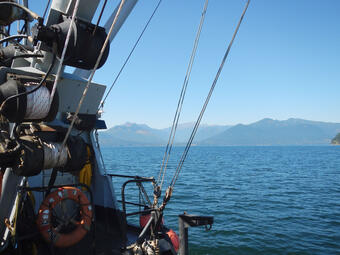A Research Cruise to Investigate Natural Versus Human Impacts on Marine Ecosystems in Hood Canal, Washington
Researchers from the USGS and the University of Washington collaborated on fieldwork in Hood Canal, a long, narrow fjord in Puget Sound, Washington.
In September 2013, researchers from the U.S. Geological Survey (USGS) and the University of Washington (UW) collaborated on fieldwork in Hood Canal, a long, narrow fjord in Puget Sound, Washington. The bottom waters in parts of Hood Canal and its terminus, Lynch Cove, suffer periodic depletions in dissolved oxygen (hypoxia), which can negatively affect ecosystem health. Most fish, for example, cannot live in hypoxic water (water with less than 30 percent of the dissolved oxygen it could contain at the prevailing temperature and pressure). Oxygen depletion in the water column most commonly results from the introduction of nutrients—such as nitrogen and phosphorus—that spur the growth of algae, whose eventual decomposition by bacteria consumes oxygen. Natural nutrient sources that contribute to low bottom-water oxygen in Hood Canal—such as land-derived plant residues and animal waste—are likely enhanced by decades of widespread urbanization, agriculture, and forestry. The recent research is directed at distinguishing natural from anthropogenic controls on bottom-water oxygen depletion and other ecosystem stressors.
USGS personnel from the Pacific Coastal and Marine Science Center (PCMSC, Santa Cruz, California) and the St. Petersburg Coastal and Marine Science Center (SPCMSC; St. Petersburg, Florida) worked with colleagues from UW aboard research vessel (R/V) Centennial to collect sediment samples for their study.
Under the direction of chief scientists Peter Swarzenski (USGS, PCMSC) and Andrea Ogston (School of Oceanography, UW), R/V Centennial steamed to Hood Canal from Friday Harbor, Washington. After the vessel entered the study area, Emily Eidam (School of Oceanography, UW) and Cordell Johnson (USGS, PCMSC) assisted in collecting a series of Van Veen surface-sediment grab samples and a long kasten core.
The Van Veen grab sampler has a clam-shell-type scoop that collects bottom sediment with minimal disturbance to the sediment surface (see a photo of a Van Veen). The kasten corer has a rectangular-shaped barrel with a heavy weight at the top that helps push it into the sediment (see the following photographs).
Sediment sampling continued at multiple sites seaward of the Skokomish River delta and into Lynch Cove. Coring sites were selected to aid in the interpretation of ecosystem stressors as well as the identification of sediment sources and the deciphering of delta evolution. Elizabeth Nesbitt and Ruth Martin (both from the Burke Museum of Natural History and the Earth and Space Sciences Department, UW) took subsamples from the cores to investigate benthic infauna—animals living in the sediment—including foraminifera, single-celled organisms whose shells commonly record environmental conditions at the time of their growth. Mary McGann (USGS, PCMSC) and Lisa Osterman (USGS, SPCMSC) will examine subsets of foraminifera for evidence of invasive species (McGann) and low-oxygen events (Osterman).
Ably assisted by the captain (David Duggins) and crew (Scott Lindgren) of R/V Centennial, the scientific party kept five long kasten cores and more than a dozen Van Veen grab samples. The sediment will be analyzed first for short-lived radioisotopes (for example, 210Pb, 137Cs, 7Be) to establish a representative geochronology at each sampling site. Subsequently, a suite of analyses will include X-radiography; grain-size analysis; concentrations and isotopic compositions of carbon and nitrogen; concentrations of trace elements such as vanadium, rhenium, and uranium, which are sensitive to reduction-oxidation conditions in the sediment; and characterization of sterols and lignin phenols, which are biomarkers indicating the sources and fate of organic matter in the sediment. With the aforementioned work on foraminifera to complement these physical and geochemical analyses, the scientists hope to distinguish historical low-oxygen events from more modern processes and may also gain insight into how climate change might impact habitats and ecosystem health in Hood Canal.
Get Our News
These items are in the RSS feed format (Really Simple Syndication) based on categories such as topics, locations, and more. You can install and RSS reader browser extension, software, or use a third-party service to receive immediate news updates depending on the feed that you have added. If you click the feed links below, they may look strange because they are simply XML code. An RSS reader can easily read this code and push out a notification to you when something new is posted to our site.






